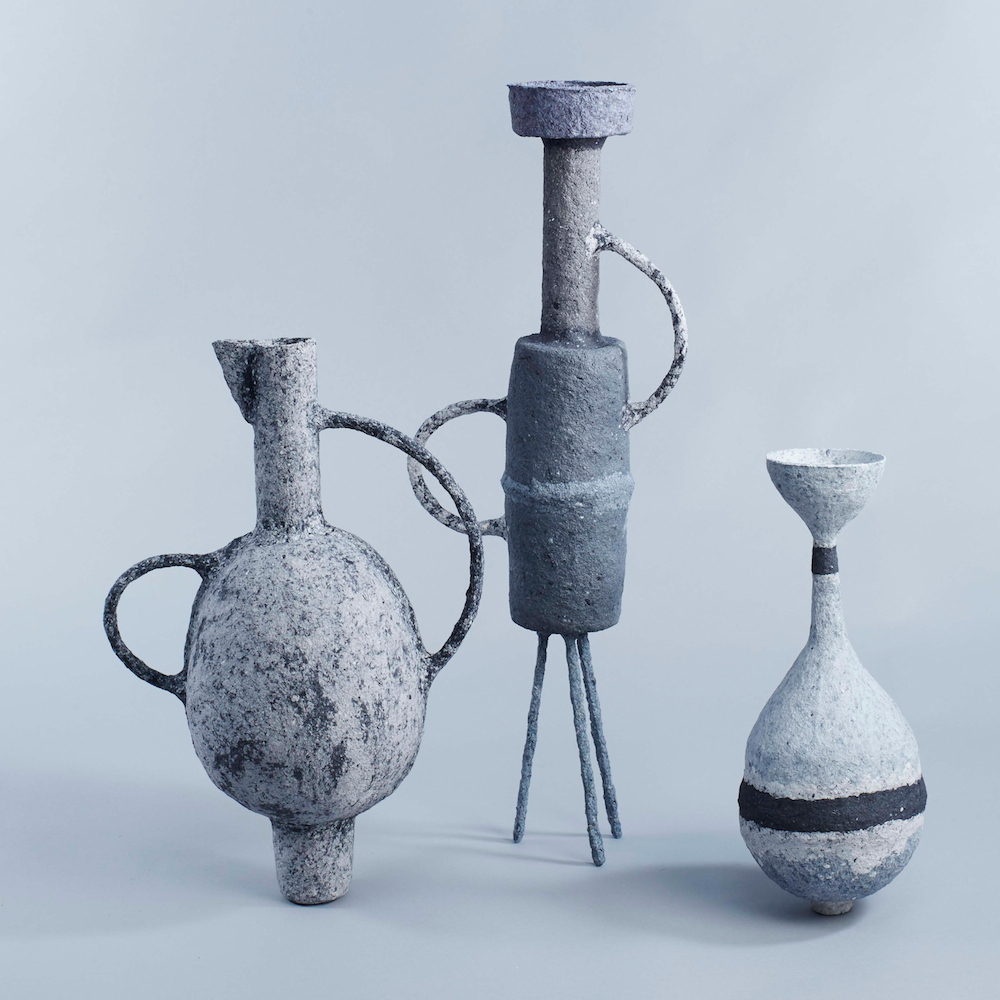LONDON — It’s not an easy thing to destroy a book. I have volumes that have sat on my shelf for eight years and even though I’ve stopped kidding myself that I’m ever going to finish some of them, I still can’t get rid of them. That would feel like defeat, maybe even sacrilege.
Even though ending a book’s time on this Earth feels wrong, books are destroyed every day. In an interview with Grafik, London artist and sculptor Ben Branagan related one such story in which he came across an elephant graveyard of books and old projector slides. The experience left an impression on him, inspiring his Monuments series of pots. Each pot is made from the pulped remains of unwanted, abandoned books. It was part of an installation at Darkroom London in February this year. He told Grafik about the concept behind the works:
One of the things I’m interested in is the objects and tools we use to store knowledge and examine the past. It’s often through material objects like pots that we read and construct histories. Books are obviously a very potent cultural signifier – the idea of destroying a book still carries a lot of power – yet we throw away and pulp a lot of books all the time, for many different reasons. Faced with a pile of abandoned books, I was interested in creating an alternative archive of the information these now redundant containers once held, returning them to an object making tradition that is prehistoric, pre-literate. Transforming one kind of container or vessel into another. Of course there is something perhaps ironic that these paper pots would perish fairly quickly in any archaeological record.
He grabbed most of the books for these works from the Library at the London College of Communication. He takes great care to explain that different schools, charities and organizations had first pick of the books before he carried them off to textual Valhalla. This winds back to the sense of committing a crime by destroying a book.
He pulped the books then molded them in an improvisational way by using simple objects he found at thrift stores. He started by arranging these shapes and sketching what the finished work could look like. He talks about making a “fictional archeology” for the different pots, going as far as labeling them with pieces that couldn’t be pulped:
I keep a record of the books before I break them down, and as I’m going through them I tend to save particular pages and the parts which won’t breakdown like spines and covers. These elements become part of their display. It’s keeping a link between the book and the pot, telling the story of the process, which is important for me. The title for this particular installation Monuments comes from a title page in one of the books.
The metaphor is easy to see. Just as vases and pots are vessels for water, flowers or any number of objects, books are vessels for knowledge. There’s a stranger angle Branagan didn’t really address explicitly, but it’s there regardless: the decay of information. The title, Monuments, puts me in the mind of a grave marker, telling me that that is where knowledge is buried. The knowledge has passed beyond my ability to access it. The pots mark the void where there was once knowledge. We’re seeing the corpse of knowledge; meaning has left its body.
This is interesting to me because I do not typically think of knowledge as being bound to the material world. I assume, naively, that once a novel is written or a scientific paper is published they go off to join a vast celestial library that humanity can access whenever they wish. The Library of Alexandria is rolling its eyes at me right now, and so are the untold scores of books that have passed beyond us through accident, violence or simple decay. This lets me know that knowledge is mortal, just like I am. It requires the same respect and care that I put into my own body.
I’d be interested in seeing projects that deal with similar themes, only within a digital space. The temptation is to think of knowledge on the Internet as even more immutable than knowledge contained within books, but that’s not the case either. It faces dangers unique to its own existence.
Ben Branagan is an artist and designer based in London, according to his biography. His work has been exhibited at galleries both in the UK and internationally, and can be found in collections including the Tate artists book archives. He is an associate lecturer in the Interactive and Visual Communication programme at University of the Arts London.
Bill Rodgers is the Managing Editor of cfile.daily.
Do you love or loathe these works of (not quite) contemporary ceramic art? Let us know in the comments.





Add your valued opinion to this post.